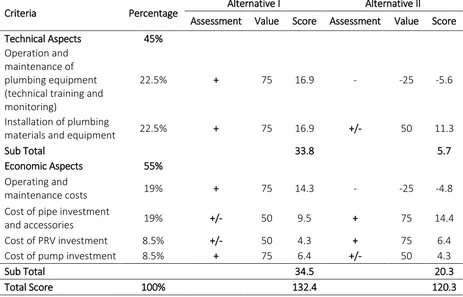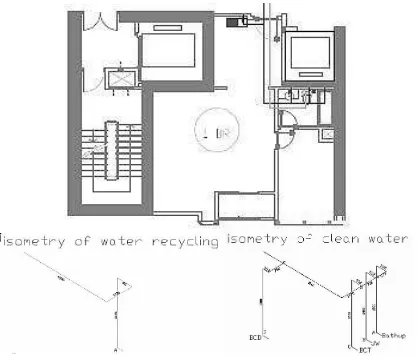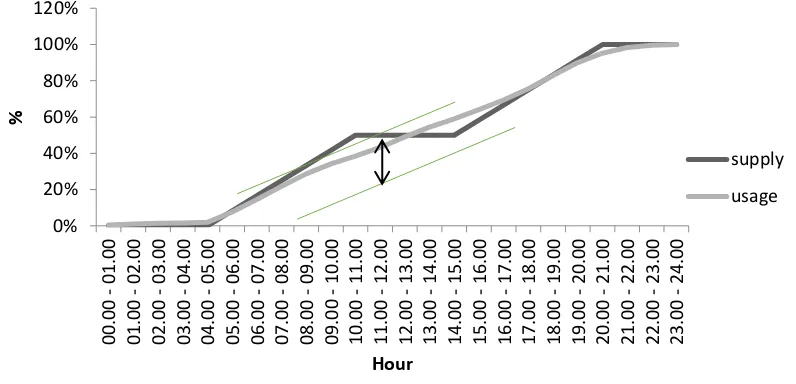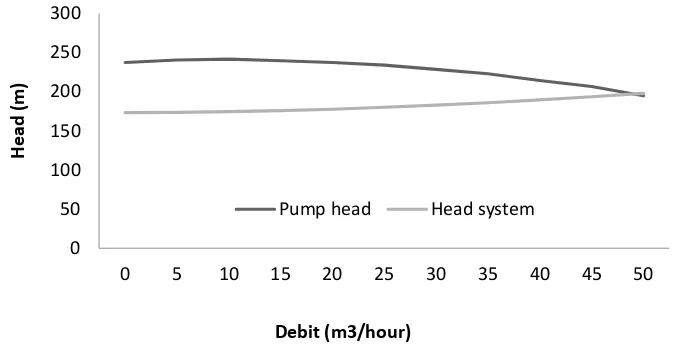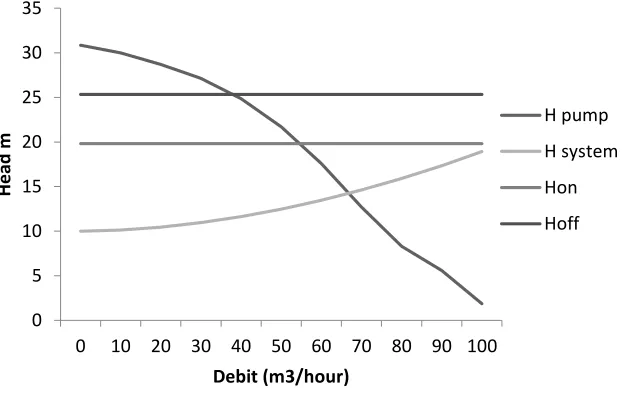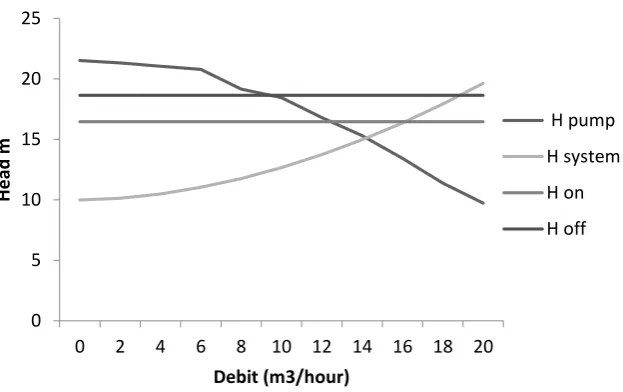DESIGN OF PLUMBING SYSTEM AT TUNJUNGAN PLAZA APARTMENT,
SURABAYA
Sarah Meilani, Ariani Dwi Astuti, Ratnaningsih
*Environmental Engineering, Faculty of Landscape Architecture and Environmental Engineering Universitas Trisakti, Jakarta, 11440, Indonesia
*Corresponding author: [email protected]
ABSTRACT
Aim: This study of plumbing system plan is aimed at planning a plumbing system that is compatible with clean water, waste water and rain water management at Tunjungan Plaza apartment, Surabaya City, Indonesia according to SNI 8153-2015, and meet 5 aspects of safety, security, simplicity, beauty, and economy. It applies water supply system which commonly used for high rise buildings, namely Roof Tank system.
Methodology and Result: Plumbing system planning methods are collecting and analyzing fluctuation in water use, planning clean water and recycled water systems by endorsing alternative piping for clean water and recycled water. In addition to water supply, recycled water system that utilizes waste water to be recycled for flushing closets and watering plants also required to be implemented. Average daily water consumption is 268 m3/day for clean water and 44 m3/day for recycled water with the
capacity of ground water tank for clean water is 564.54 m3 and recycled
water is 62 m3. Conclusion, significance and impact study:Clean water
1.
INTRODUCTION
The rapid growth of population in Surabaya as the second biggest city in Indonesia contributed
the same problem as many cities in the world should deal with, which ishousing. Lands
availability for housing is getting so limited that causes apartment to be the best option to
resolve this problem.The most important thing in supporting daily activities living in an
apartment is a feasible plumbing system that manages water flows throughout apartment
building. Tunjungan Plaza Apartment Constructionrefers to Standard National Indonesia or SNI
8135:2015 that regulates piping network designing standard including the provision of drinking
water, wastewater treatment, supporting building, distribution and drainage piping, altogether
with all connections, tools, and equipment installed in the plot and building, as well as water
heater and ventilation for the same purpose. This paper of Plumbing System Design
aimstodesign a plumbing system that is compatible with clean water, wastewater and rainwater
management at Tunjungan Plaza apartment, according to SNI 8153-2015, and meet 5 aspects of
safety, security, simplicity, beauty, and economy.
2.
RESEARCH METHODOLOGY
The stages of water plumbing system designing methods are: determining the location and time
line of the design; gathering references, literature, and guidelines studies; collecting and
analyzing primary data (fluctuation in water use) and secondary data (layout drawing of the
apartment, maximum daily rainfall); designing clean water and recycled water systems by
endorsing alternative piping for clean water and recycled water; determining and drawing lines
and isometrics; calculating dimensions of horizontal branch pipes and vertical pipes; calculating
critical points of the building and determining PRV placement; calculating upper and lower
reservoir capacities; calculating reservoir capacity and heads of transfer pumps and booster
pumps. While designing wastewater and vent systems stages are determining and drawing lines
and isometrics; calculating dimensions of horizontal branch pipes and vertical pipes. Stages of
designing rainwater system are determining rainfall intensity; calculating roof area; determining
lines and area of open flat gutter; calculating the dimensions of horizontal pipes, vertical pipes,
and roof gutter diameter, designing infiltration. All systems are ended by projecting investment
3.
RESULTS AND DISCUSSION
3.1
Floor Analysis
This apartment is a multi-function building that blends residential, commercial and
officeutilizationinone tower with 36 floors. Floors UG (underground) to 3 are the sections of
shopping mall providing a variety of needs, floors 8 to 16 are office buildings while floors 17 to
36 are for residence apartments with type of 1-3 Bedrooms. Floor 22 to 36 have typical
architectural. Each floor has a different height. The height of typical floors (floors 22 to 36),
floors 20 and 19 is 3.3 m, whlie floors 17 and 18 is 3.5 m, and floor 21 is 4 m.
3.1
Clean Water and Recycled Water Systems
Tunjungan Plaza apartment usesclean water from local state-owned water company of the City
of Surabaya. This 24 hours water supply is collected in the ground water tank (GWT) or lower
reservoir located on basement floor. A transfer pump then pushes the water up to the roof tank
or upper reservoir and distribute it to each occupant with gravity system. Recycled water
system using wastewater is also recommended. It is used for flushing water on the toilet tank.
3.2
Clean Water Piping System
Development of clean water piping network should considering the 5 aspects which mentioned
before. Two alternatives plumbing system designs were compared to find the plumbing
equipment designed workmosteffectively. To generate the chosen option, multi-criteria analysis
was compared on the two alternatives including weighting as well as the scoring system to each
criterion. Weighting for each aspect was divided by technical aspect 45% and for economic
aspect 55%. The reason why Economic aspect has a weight of 55% because it plays an
important role for investment, maintenance, and operational costs while technical aspect
involves in running of plumbing equipment effectively.
The assessment result in Table 1 below indicates that the total score of alternative 1 is
132.4 which is considered as high category, while alternative 2 is 120.3 or lower than first
alternative. Therefore, alternative 1 is recommended with 2 vertical pipes consisting of 1
vertical pipe without booster pump and 1 vertical pipe with booster pump. To obtain volume of
reservoir, comparative water use fluctuation data was used. Benchmarking data used were from
was done every 1 hour for 7 days consisting of 5 weekdays and on the weekend. Data obtained
is in unit of m3/hour, the percentages of clean water usage in 1 day per hour was calculated as well as the average of percentages of water usage during weekdays and weekend. Data
collection on weekdays and weekend, data from direct observation, and another supporting
data such as water needs are shown in Table 2.
Table 1 The assessment of alternative clean water drainage system
Criteria Percentage Alternative I Alternative II
Assessment Value Score Assessment Value Score
Technical Aspects 45%
Table 2 The details of results of water needs data retrieval
Apartement Merr Manyar
Location Surabaya Surabaya
Type of Occupant Employee, Student, Family Employee, Student Peak Hour Use of Water 06.00 – 07.00 06.00 – 07.00
18.00 – 19.00 18.00 – 19.00
Percentage of Occupancy 92% 80%
Number of Occupants (people) 954 778
Average Water requirement (m3/day)
253 118
It can be concluded that the fluctuation of water use that is approaching the characteristic
of designing apartment is Merr apartment. Fluctuation data in water usage was required to
determine reservoir volume, as well as the amount of water needs in the apartment.
3.3
Calculation of the Size of Clean Water and Recycled Water Horizontal Branch Pipes
Clean Water demand has total Head Loss of 11,7482 m and recycled water has total Head Loss
of 21,9766 m for residence with 1 BR type. Architectural, clean water and recycled isometry line
of 1 BR type can be seen in Figure 1.
Figure 1 The lines and isometrics of clean water and recycled water of residence with 1BR-type
3.4
Calculation of the Size of Clean Water and Recycled Water Vertical Pipes
Two vertical pipes for clean water and 2 vertical pipes for recycled water were also designed.
3.5
Calculation of Building Critical Points for Determination of PRV and Booster
Pumps
If the remaining pressure exceeds allowable pressure of 3.5 kg/cm2, then it is necessary to install PRV (Japan International Cooperation Agency (JICA), 1978). Based on calculation, PRVsare
installed on floors 26, 18, 10, and 3. If the standard pressure of 1 kg/cm2 is not met, then it needs booster pumps. They will be installed to supply water for floors 30-36, according the
calculation result.
3.6
Upper Reservoir
Capacity or volume of upper reservoir can determined based on fluctuation of water use within
24 hours. On the design of Plumbing system for Tunjungan Plaza apartment, water entering the
upper reservoir was assumed by pumping for 12 hours as shown in Figure 2.
3.7
Lower Reservoir
Lower reservoir or ground water tank is located on the bottom floor, i.e., basement floor. A
24-hour supply is needed to determine the capacity of lower reservoir. The supply will be obtained
from local water company of the City of Surabaya. The following Figure 3 is graph of lower
reservoir.
Figure 2 The graphs of cumulative supply and cumulative usage on holidays
Figure 3 The graph of cumulative supply and cumulative usage of bottom reservoir
3.8
Transfer Pumps
Transfer pump function is to pump water from the ground water tank to the roof tank. It should
be adjusted in line with the designed clean water needs, the head required for water to pump
up, and the characteristic of the pump that is available on the market. The transfer pumps will
be operated for 12 hours. There are 2 transfer pumps to be recommended, which is 1 for clean
water and 1 for recycled water. The calculation indicates the curves of transfer pump in Figure 4
for clean water and Figure 5 for recycled water.
Figure 4 The curve of clean water transfer pump
Figure 5 The curve of recycled water transfer pump
3.9
Booster Pumps
Booster pump is pump to serves particularly to meet the needs of clean water on the top
floorssince there is enough remain pressure to comply the requirement. The standard minimum
pressure in each floor is 1 kg/cm2 (Noerbambang et al., 1988). Booster pumps will be installed on apartment to supply water for 7 top floors, which are floors 36-30. The calculation obtains
the curves of booster pump as in Figure 6 for clean water and Figure 7 for recycled water.
Figure 6 The graph of clean water booster pump
Figure 7 The graph of recycled water booster pump
wastewater and the needs of recycled water used for flushing on toilet tank and watering the
plants. The amount of clean water consumption is 269 m3/day. Wastewater generated from clean water ranges about 80-90% (Setiyono, 2009). The assumption of wastewater
quantitygenerated from clean water usage is 80%, so the amount of wastewater in the
apartment is 215 m3/day. The assumption of wastewater recycled is 30%, so the recycled water production is 65 m3/day. The result of recycled water used for flushing on toilet tank is 44
m3/day and for watering the plants is 21 m3/day.
3.11
Sewerage and Vent Systems
The sewerage and vent systems designs are separate systems using gravity system by arranging
the position and tilt of the wastewater pipes. Unit shaft or the shaft in each residence is
functioned for wastewater and vent vertical pipes. The wastewater from each plumbing
equipment is drained to the wastewater, dirty water, and vent vertical pipes. Vent vertical pipe
equipment. Wastewater at offices, public toilets, and malls are flowed to STP.
3.12
Calculation of the Size of Wastewater Horizontal Branch Pipes
Sewerage system design uses separate system between wastewater (from hand wash basin,
kitchen sink, urinal bowl, and floor drain) and dirty water from toilet tank. Based on the
calculation of wastewater and vent horizontal branch pipes of the residence with 2BR-1 type,
the diameter of pipe for wastewater ranged between 42 mm to 60 mm, the diameter of pipe
for dirty water was 89 mm, and the diameter of pipe for vent ranged between 45 mm to 65
mm.
3.13
Calculation of the Size of Wastewater and Vent Vertical Pipes
Determination of vertical pipesdiameter based on total number of plumbing fixture unit on
horizontal branch pipes for wastewater, dirty water, and vent. The diameter of pipe for dirty
water ranged between 89 mm to 140 mm, the diameter of pipe for wastewater ranged
between 42 mm to 114 mm, and the diameter of pipe for vent ranged between 42 mm to 114
mm.
3.14
Rainwater System
Rainfall data from Indonesian Agency for Meteorology, Climatology and Geophysics for the City
of Surabaya, Station Perak 1, required for deciding the dimensions of the pipe to channel
rainwater. The data are the average maximum daily rainfall data during the last 10 years.
Rainwater falling on the roof and from the balcony of each residence is drained to infiltration
well by gravity.
3.15
Rainwater Drainage System
Roof gutter is divided into 10 sections. The slope of the roof designed is 1%. The calculation
resultis the diameter of rainwater vertical pipe ranged between 60 mm to 89 mm.
3.16
Infiltration Well
Table 3 The total Investment cost plan
Information Cost (Rp)
Clean water supply 982,487,305
Reservoir 735,196,593.00
The distribution of wastewater and ven 236,627,087 distribution of rain water 165,007,920
Infiltration wells 38,378,601 m3/day. The clean water system chosen will use 2 vertical pipes: 1 vertical pipe for gravity pipe and 1 vertical pipe for booster pipe. The booster pumps will be installed to supply pressure for
the 7 top floors. Clean water will be obtained from local water company of the City of Surabaya
and wastewater treatment process will generate recycled water. It is recommended to have 1
upper reservoir for both clean water and recycled water. The capacity of upper reservoir for
clean water is 112 m3 and 23 m3 for recycled water. 12 hours transfer pump will be operated for these reservoirs. The capacity of lower reservoir for clean water is 564.54 m3 and 61.44 m3 for recycled water. Sewerage system which will be applied is a separate system between
wastewater and dirty water. Wastewater and dirty water will be processed in sewage treatment
plant (STP). Recycled wastewater will be reused for flushing on toilet tank and watering the
plants. Rainwater will be flowed through roof gutter with diameters of 114 mm and 89 mm and
vertical pipes with diameters of 60 mm and 89 mm. The rainwater will then be drainaged into
the infiltration well; A unit of infiltration well is designed with a diameter of 3 meters; and 3
meters high. The cost of the investment of plumbing equipmentand construction at Tunjungan
Plaza apartment is Rp 2,135,213,315.00 while the price per unit for clean water is Rp
5.
REFERENCES
SNI. 8153-2015. (2015). Sistem Plambing Pada Bangunan Gedung. Jakarta: Badan Standar Nasional.
Noerbambang, Soufyan M. dan Takeo Morimura. 1988. Perancangan dan Pemeliharaan Sistem Plambing. Jakarta : PT Pradnya Paramita
Setiyono. 2009. Disain Perencanaan Instalasi Pengolahan Air Limbah (IPAL) dan Reuse Air di Lingkungan Perhotelan. JAI Vol 5 No. 2. Jakarta: BPPTeknologi
Japan International Cooperation Agency (JICA). 1978. Design Criteria for Waterworks and Facilities. Japan Water Works Assosiation.
